Evaluation of the Reliability and Lifetime Prediction of 150 GHz Athermal AWG Module with Metal Temperature Compensation Board
Abstract
:1. Introduction
2. Design of the Athermal AWG
2.1. Thermal Compensation Design
2.2. Finite Analysis of Temperature Compensation Board
3. Athermal AWG Fabrication Results
Fabrication Results
4. Reliability Test Results for Internal and External Environmental Application
Reliability Tests Result
5. Lifetime Prediction
5.1. Accelerated Life Test
5.1.1. Preparation
5.1.2. Accelerated Life Test Model
5.1.3. Life–Stress Relationship and Acceleration Factor
5.2. High Temperature Accelerated Life Test Result of Athermal AWG Module
6. Conclusions
Author Contributions
Funding
Data Availability Statement
Conflicts of Interest
References
- Pittalà, F.; Braun, R.P.; Böcherer, G.; Schulte, P.; Schaedler, M.; Bettelli, S.; Calabrò, S.; Kuschnerov, M.; Gladisch, A.; Westphal, F.-J.; et al. 1.71 Tb/s single-channel and 56.51 Tb/s DWDM transmission over 96.5 km field-deployed SSMF. IEEE Photonics Technol. Lett. 2022, 34, 157–160. [Google Scholar] [CrossRef]
- Pandey, G.; Choudhary, A.; Dixit, A. Wavelength Division Multiplexed Radio Over Fiber Links for 5G Fronthaul Networks. IEEE J. Sel. Areas Commun. 2021, 39, 2789–2803. [Google Scholar] [CrossRef]
- Luo, Y.; Chanclou, P.; Skouby, K.E.; Zhao, H.; Asaka, K. Guest Editorial: Enhanced Fronthaul for 5G and Beyond. IEEE Wirel. Commun. 2022, 29, 92–93. [Google Scholar] [CrossRef]
- Honda, K.; Nakamura, H.; Hara, K.; Sone, K.; Nakagawa, G.; Hirose, Y.; Hoshida, T.; Terada, J. Wavelength control method of upstream signals using AMCC in WDM-PON for 5G mobile fronthaul. Opt. Express 2019, 27, 26749–26756. [Google Scholar] [CrossRef] [PubMed]
- Liu, D.; Xu, H.; Tan, Y.; Shi, Y.; Dai, D. Silicon photonic filters. Microw. Opt. Technol. Lett. 2020, 6, 2252–2268. [Google Scholar] [CrossRef]
- Bucio, T.D.; Khokhar, A.Z.; Mashanovich, G.Z.; Gardes, F.Y. Athermal silicon nitride angled MMI wavelength division (de)multiplexers for the near-infrared. Opt. Express 2017, 25, 27310–27320. [Google Scholar] [CrossRef] [PubMed]
- Melati, D.; Verly, P.G.; Delâge, A.; Cheben, P.; Schmid, J.H.; Janz, S.; Xu, D.X. Athermal echelle grating filter in sili-con-on-insulator using a temperature-synchronized input. Opt. Express 2018, 26, 28651–28660. [Google Scholar] [CrossRef] [PubMed]
- Leick, L.; Boulanger, M.; Nielsen, J.G.; Imam, H.; Ingenhoff, J. Athermal AWGs for colourless WDM-PON with −40 °C to +70 °C and underwater operation. In Proceedings of the Optical Fiber Communication Conference and Exposition and the National Fiber Optic Engineers Conference, Anaheim, CA, USA, 5–10 March 2006; Optical Society of America: Washington, DC, USA, 2006. [Google Scholar]
- Andrea, T.; Thomas, A.; Rickman, A. CMOS compatible athermal silicon photonic filters based on hydro-genated amorphous silicon. Opt. Express 2022, 30, 19311–19319. [Google Scholar]
- Chen, C.; Wang, H.; Wang, L.; Sun, X.; Wang, F.; Zhang, D. Athermal polarization-independent 49-channel UV curable all-polymer arrayed waveguide grating (AWG) multiplexer. Optik 2014, 125, 521–525. [Google Scholar] [CrossRef]
- Junichi, H.; Nara, K. Development of Wide Operating Temperature Range (−30~70 °C) Athermal AWG Module with High Reliability. Furukawa Rev. 2006, 30, 1–6. [Google Scholar]
- Wu, X.; Liu, C.; Liu, W.; Li, C.; Yuan, Z.; Guan, C.; Wu, K.; Tang, F.; Min, Y.; Chen, H.; et al. Integrated athermal ar-rayed-waveguide grating multiplexer and demultiplexer with all-metal compensating rod for broadband temperature application. Appl. Opt. 2018, 57, 6207–6212. [Google Scholar] [CrossRef] [PubMed]
- Wang, M.; Chen, X.; Guan, C.; Yu, J. Monolithic integrated athermal arrayed-waveguide grating multiplexer and demulti-plexer. In Fiber Optic Sensing and Optical Communication; International Society for Optics and Photonics: Beijing, China, 2018; p. 1084902. [Google Scholar]
- Hasegawa, J.; Kazutaka, N. Ultra-wide temperature range (−30~70 °C) operation of athermal AWG module using pure aluminum plate. In Optical Fiber Communication Conference; Optica Publishing Group: Washington, DC, USA, 2006. [Google Scholar]
- Yun, K.-S.; Yu, C.-H.; Lim, K.-S.; Kim, Y.-S.; Jeon, I. High Reliability Evaluation and Lifetime Prediction of 50 GHz Athermal AWG Module. Appl. Sci. 2021, 11, 11107. [Google Scholar] [CrossRef]
- Lohrmann, R. 4 Filters for CWDM WDM. Coarse Wavelength Division Multiplexing: Technologies and Applications; CRC Press: London, UK, 2018; p. 91. [Google Scholar]
- Ticknor, A.J.; McGinnis, B.P.; Tarter, T. Efficient passive and active wavelength-stabilization techniques for AWGs and in-tegrated optical filters. In Proceedings of the Optical Fiber Communication Conference and Exposition and the National Fiber Optic Engineers Conference, Anaheim, CA, USA, 6 March 2005; Optical Society of America: Washington, DC, USA. [Google Scholar]
- Kang, D.; Yang, S.; Park, J. A temperature independent hybrid AWG device based on silica/pentafluorostyrene-glycidylmethacrylate-fluoroethylmethacrylate terpolymer overclad. J. Eng. 2022, 2022, 873–877. [Google Scholar] [CrossRef]
- Bong, K.J. Athermal Arrazyed Waveguide Grating using Precise Parallel Movement Module, and Manufacturing Method Therefor. U.S. Patent No. 11,092,741, 17 August 2021. [Google Scholar]
- Telcordia-GR-1221-CORE. Generic Reliability Assurance Requirements for Passive Optical Components. 2010. Available online: https://telecom-info.njdepot.ericsson.net/site-cgi/ido/docs.cgi?ID=SEARCH&DOCUMENT=GR-1221&#ORD (accessed on 9 October 2021).
- Telcordia-GR-1209-CORE. Generic Requirements for Passive Optical Components. 2010. Available online: https://telecom-info.njdepot.ericsson.net/site-cgi/ido/docs.cgi?ID=SEARCH&DOCUMENT=GR-1209& (accessed on 9 October 2021).
- Kanarek, P.; Meeker, W.Q.; Hahn, G.J. Volume 10: How to Plan an Accelerated Life Test: Some Practical Guidelines. Technometrics 1987, 29, 491. [Google Scholar] [CrossRef]
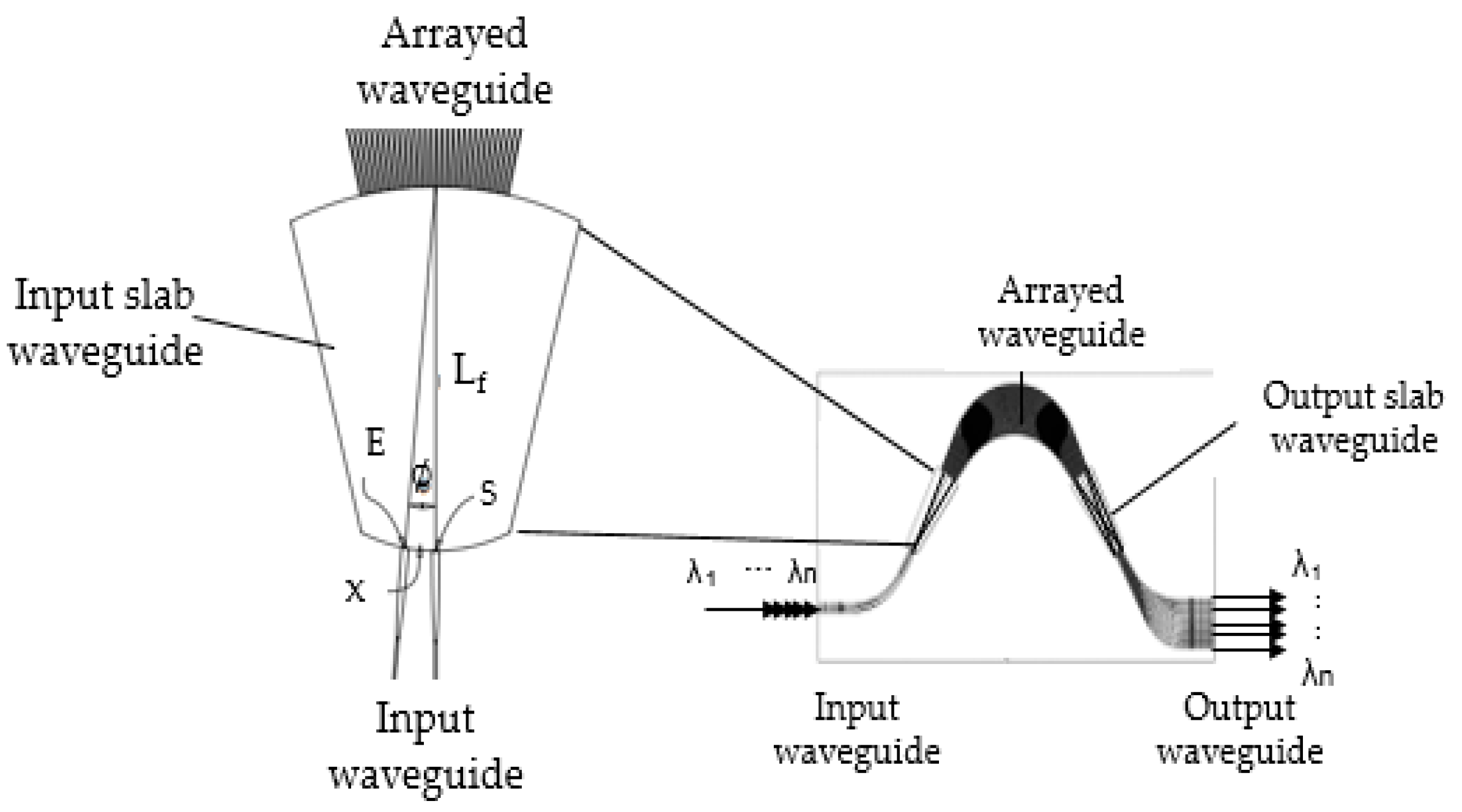



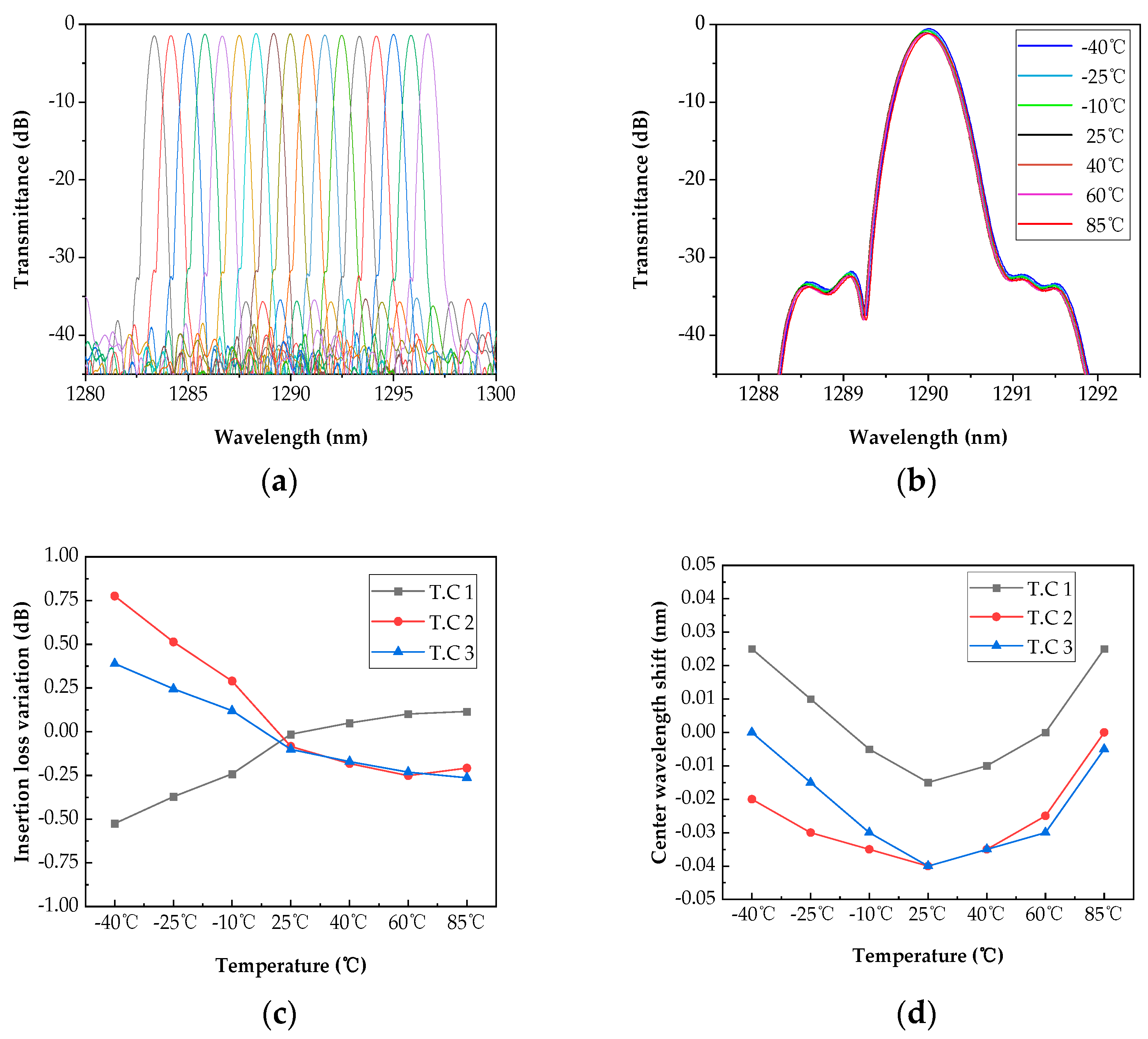

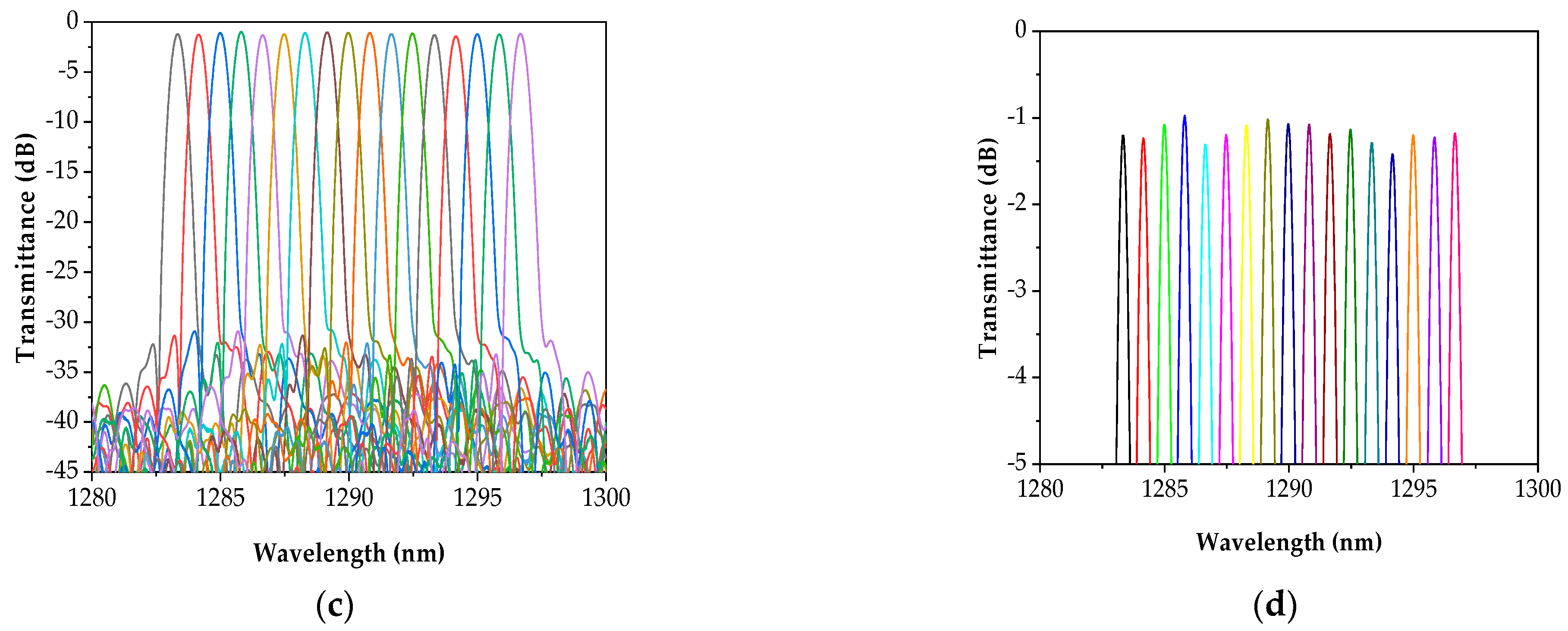
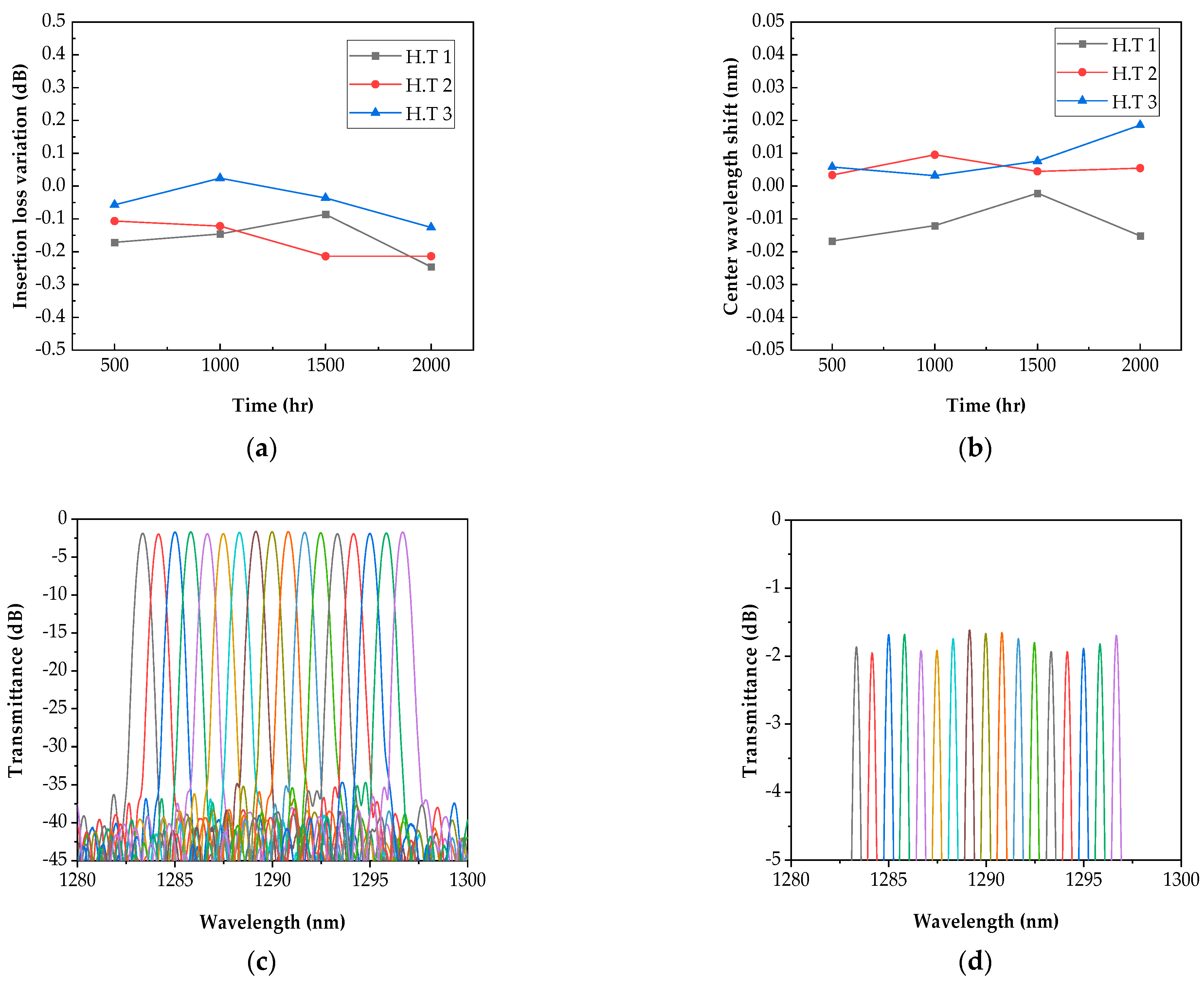

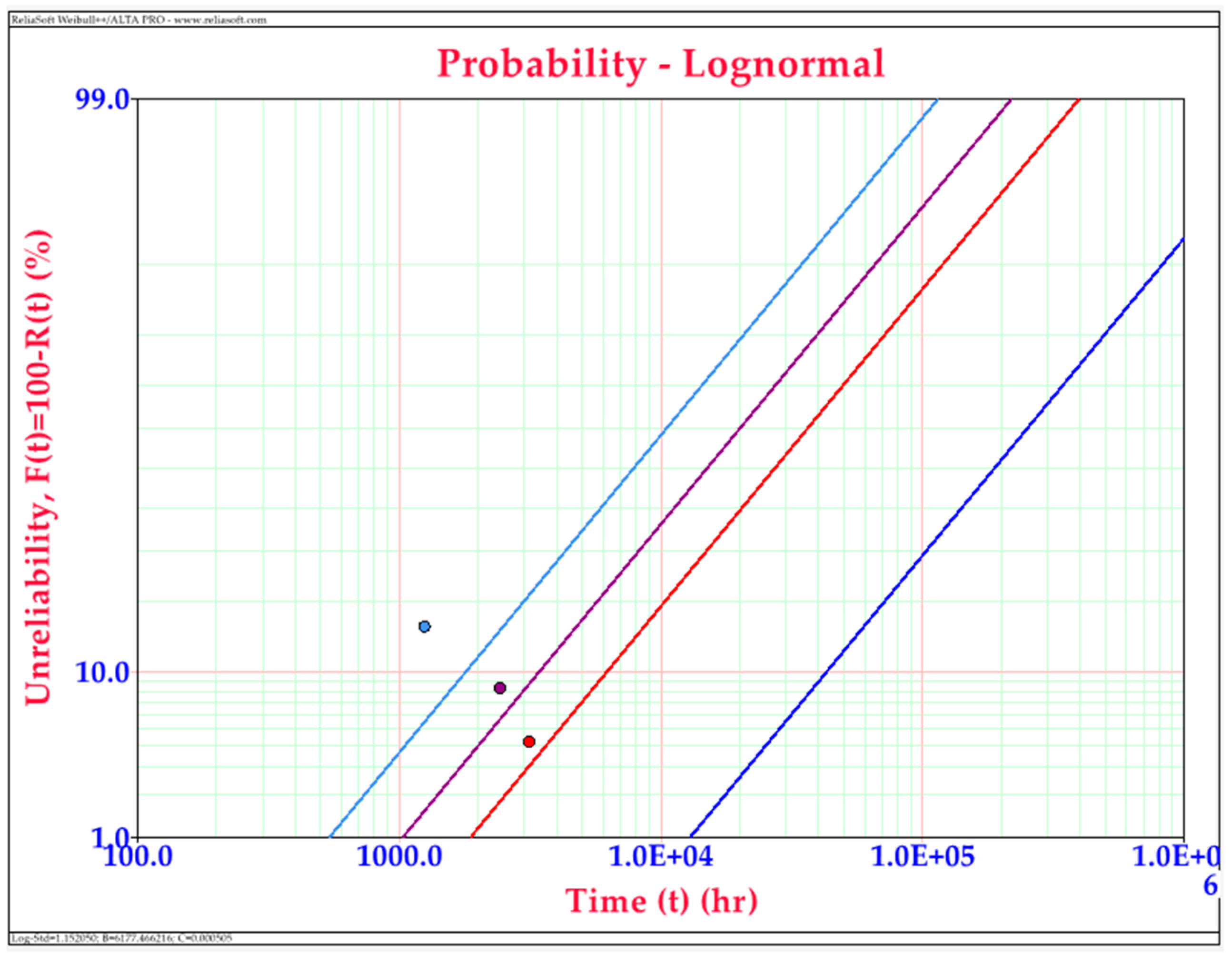
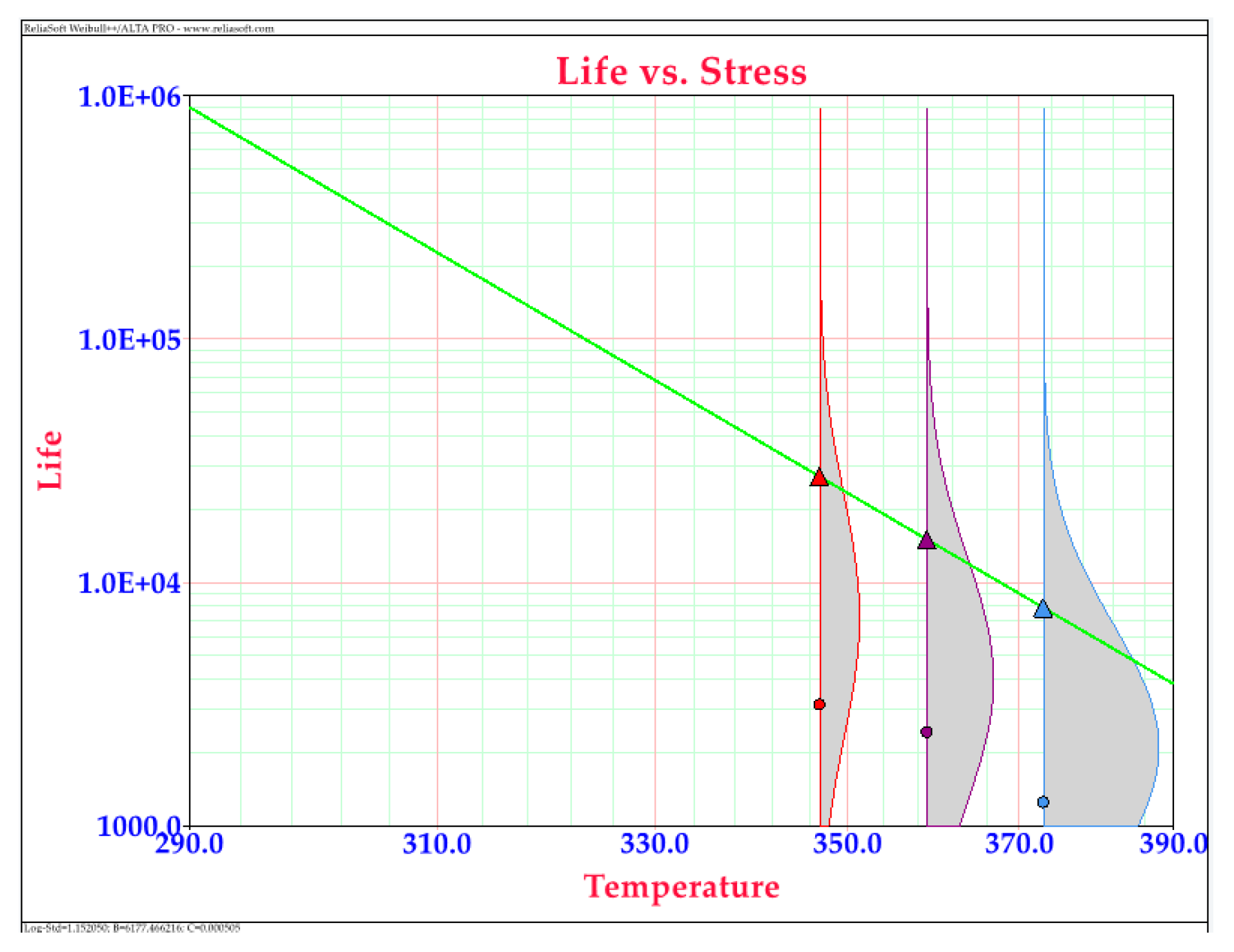
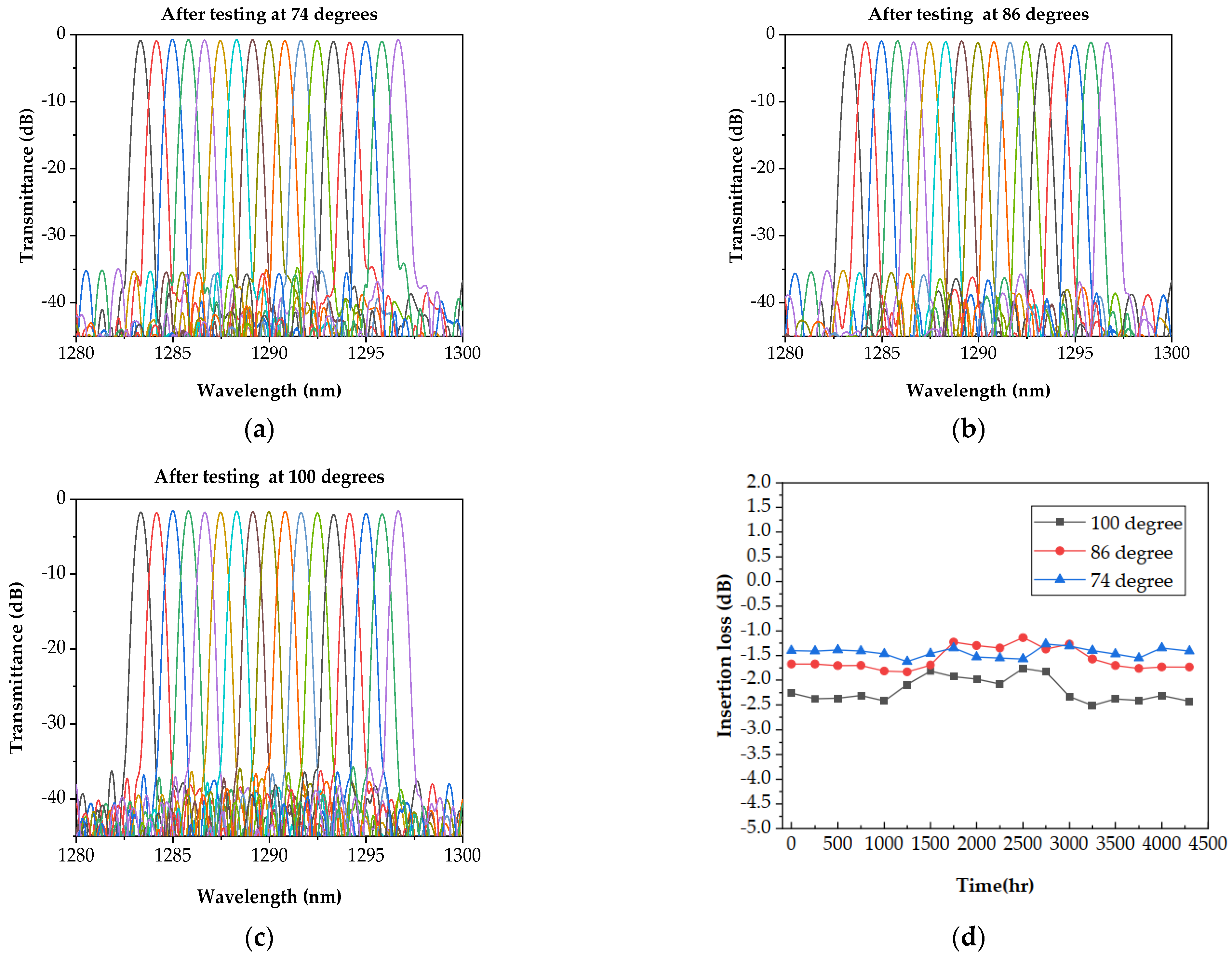
| Parameter | Values | |
|---|---|---|
| Channel spacing | 150 GHz | |
| Number of channels | 17 | |
| Length of the free propagation region | Lf | 3020 µm |
| Length difference of arrayed waveguide | ∆L | 53.23 µm |
| Input/Output waveguide at slab input and output | D | 7.0 µm |
| Effective group index of arrayed waveguide at R.T. | ng | 1.474 |
| Effective mode index of slab waveguide at R.T. | ns | 1.458 |
| Test | Conditions | Number | Channel | Results | ||
|---|---|---|---|---|---|---|
| Average | ||||||
| C.W. Deviation (nm) | IL Deviation (dB) | IL (dB) | ||||
| Mechanical shock | 500 G, half-sine, 1 ms, 3 drops/axis 6 axis | 3 | 1 ch. | 0.003 | 0.10 | −2.24 |
| 17 ch. | 0.005 | 0.01 | −1.80 | |||
| 1~17 ch. | 0.003 | 0.03 | −2.00 | |||
| Vibration | 20 G, 20–2000 Hz 4 min/cycles, 4 cycles/axis, 3 axis | 3 | 1 ch. | 0.001 | 0.14 | −1.78 |
| 17 ch. | 0.000 | 0.07 | −1.61 | |||
| 1~17 ch. | 0.001 | 0.05 | −1.63 | |||
| Temp. cycl. | −40–85 °C, 2000 cycles | 3 | 1 ch. | 0.009 | 0.02 | −2.01 |
| 17 ch. | 0.004 | 0.07 | −1.88 | |||
| 1~17 ch. | 0.007 | 0.11 | −1.93 | |||
| High-temp. storage | 85 °C, 2000 h | 3 | 1 ch. | 0.000 | −0.18 | −1.96 |
| 17 ch. | 0.003 | −0.24 | −1.80 | |||
| 1~17 ch. | 0.003 | −0.20 | −1.83 | |||
| Low-temp. storage | −40 °C, 2000 h | 3 | 1 ch. | 0.003 | 0.07 | −2.18 |
| 17 ch. | 0.002 | −0.05 | −2.27 | |||
| 1~17 ch. | 0.001 | −0.02 | −2.13 | |||
| Cycl. moisture resistance | 25–65 °C, 80–100% R.H. −10 °C, 10 cycles | 3 | 1 ch. | 0.001 | −0.12 | −2.25 |
| 17 ch. | 0.002 | −0.40 | −2.40 | |||
| 1~17 ch. | 0.005 | −0.20 | −2.20 | |||
| Temperature (°C) | Number |
|---|---|
| 74 | 16 |
| 86 | 8 |
| 100 | 4 |
| Distribution | Likelihood |
|---|---|
| Lognormal | −33.40 |
| Weibull | −33.85 |
| Exponential | −34.07 |
| Temperature (°C) | Number | Fail | |
|---|---|---|---|
| Quantity | Time | ||
| 74 | 16 | 1 | 3150 h |
| 86 | 8 | 1 | 2430 h |
| 100 | 4 | 1 | 1250 h |
Publisher’s Note: MDPI stays neutral with regard to jurisdictional claims in published maps and institutional affiliations. |
© 2022 by the authors. Licensee MDPI, Basel, Switzerland. This article is an open access article distributed under the terms and conditions of the Creative Commons Attribution (CC BY) license (https://creativecommons.org/licenses/by/4.0/).
Share and Cite
Yun, K.-S.; Yu, C.-H.; Lim, K.-S.; Kim, W.-C.; Kim, S.-Y.; Jeon, I. Evaluation of the Reliability and Lifetime Prediction of 150 GHz Athermal AWG Module with Metal Temperature Compensation Board. Processes 2022, 10, 2120. https://doi.org/10.3390/pr10102120
Yun K-S, Yu C-H, Lim K-S, Kim W-C, Kim S-Y, Jeon I. Evaluation of the Reliability and Lifetime Prediction of 150 GHz Athermal AWG Module with Metal Temperature Compensation Board. Processes. 2022; 10(10):2120. https://doi.org/10.3390/pr10102120
Chicago/Turabian StyleYun, Kwang-Su, Chong-Hee Yu, Kwon-Seob Lim, Wan-Chun Kim, Su-Yong Kim, and Insu Jeon. 2022. "Evaluation of the Reliability and Lifetime Prediction of 150 GHz Athermal AWG Module with Metal Temperature Compensation Board" Processes 10, no. 10: 2120. https://doi.org/10.3390/pr10102120
APA StyleYun, K.-S., Yu, C.-H., Lim, K.-S., Kim, W.-C., Kim, S.-Y., & Jeon, I. (2022). Evaluation of the Reliability and Lifetime Prediction of 150 GHz Athermal AWG Module with Metal Temperature Compensation Board. Processes, 10(10), 2120. https://doi.org/10.3390/pr10102120







